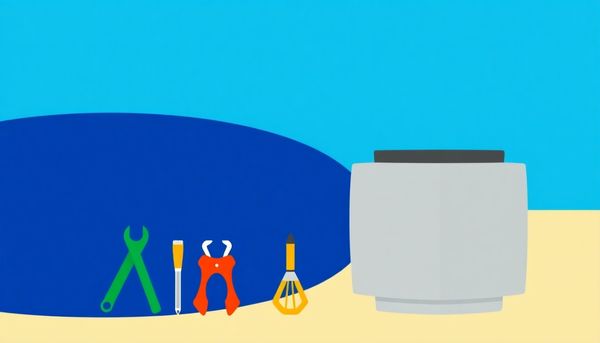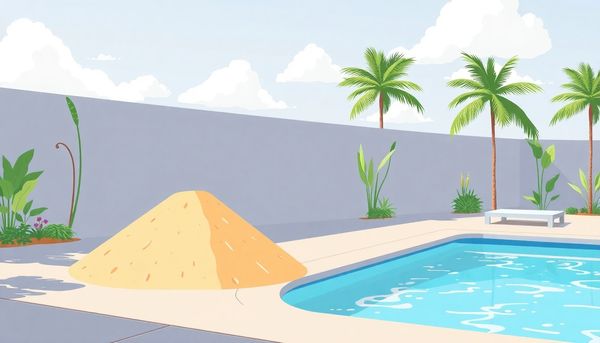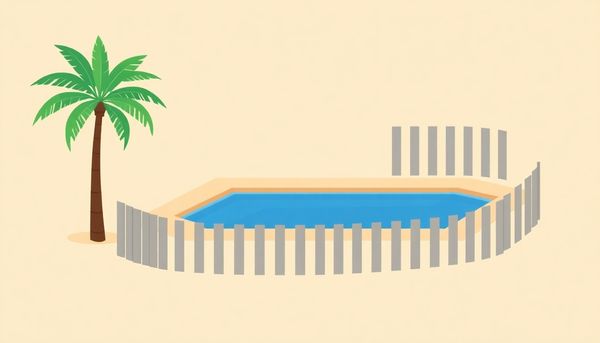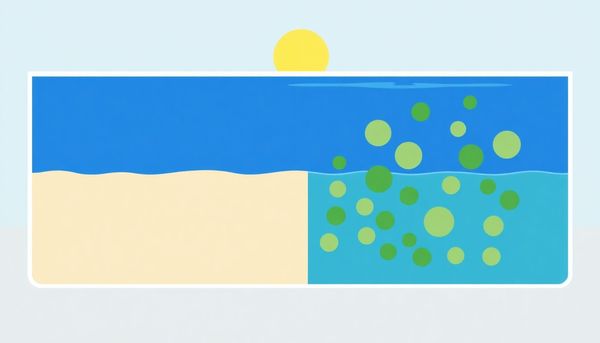How to Effectively Remove Sand from Your Pool
September 25th, 2024
September 25th, 2024
On a sunny afternoon, there's nothing quite like lounging by the pool, the gentle ripple of water providing a calming backdrop to a perfect day. However, the tranquility can quickly turn into a nuisance when a gritty, unwelcome guest—sand—appears at the bottom of your oasis. This common but perplexing issue can leave homeowners scratching their heads, wondering how such a substance found its way into their beloved pool sanctuary.
Sand often sneaks in through several unexpected avenues. While your kids' enthusiastic cannonballs or a gusty breeze may seem the likely culprits, the real source might be more insidious. Faulty pool equipment, particularly a malfunctioning sand filter, can gradually deposit fine grains. Alternatively, nearby landscaping or recent maintenance work can inadvertently contribute to this sandy dilemma.
Understanding the origins is crucial, but tackling the issue head-on with effective methods is where the real challenge lies. From regular vacuuming routines to employing specialized equipment, there’s a variety of strategies to reclaim your pool’s pristine condition. Sharing a poignant moment from last summer, I remember battling a stubborn sand invasion myself. A combination of targeted cleaning and a meticulous inspection of my filtration system eventually restored my pool’s inviting appeal.
In the sections that follow, we’ll unpack these strategies and offer insights on not only how to bid farewell to sand but also how to prevent its return. Rediscovering your pool’s sparkle has never been so achievable.

It's a sunny afternoon, and you're all set to relax by your pool, but something crunchy underfoot catches your attention. Sand. An unexpected guest in your backyard oasis. Before you can tackle this gritty nuisance, it's crucial to identify its source.
First, consider your filtration system. Sand filters, while efficient, are often the prime suspects. Over time, parts such as the standpipe or laterals might develop cracks. These cracks allow sand to escape and find its way into your pool. If you've recently noticed your pool's water isn't as pristine as usual, this might be your culprit.
Perhaps you don’t have a sand filter. In that case, look at your surroundings. Are there areas in your yard that could be introducing sand into the pool? Wind can easily blow sand from nearby landscaping or construction areas. Kids playing nearby, with sandy feet or toys, can unintentionally add to the mix.
Another possibility, albeit less likely, involves a mysterious algae invader. What appears as sand may actually be mustard algae, a sneaky pool pest that mimics the appearance of sand. A simple brush test can reveal its true nature, dispersing into a cloud if it’s algae.
Identifying the source of sand is the first step in reclaiming your pool space, ensuring that your sanctuary remains a perfect retreat from the summer heat.
Uncovering the cause of sand in your pool requires a bit of detective work, especially if you suspect a sand filter malfunction. Start by considering the filter's internals—often the culprit lies within the standpipe and laterals. Imagine the standpipe as the backbone of your filter system, channeling water where it needs to go. A crack in this component can disrupt the flow, allowing sand to escape and mix with pool water.
Notably, the laterals play a crucial role too. Positioned at the bottom of the filter, they are the guardians that keep sand at bay. Each lateral features tiny perforations, designed to let clean water pass while keeping sand contained. However, if these laterals crack, sand will sneak through these openings, finding its way into your pristine pool.
In my experience, patience and preparation are key. Before diving into repairs, ensure you have replacement standpipes and laterals handy. This foresight can save you from prolonged pool downtime. Replacing these components involves a process similar to changing filter sand, with the added task of swapping out damaged parts.
Successfully restoring your filter sets the stage for the final cleanup. Grab a pool vacuum and focus on areas beneath the return jets where sand tends to gather. With thorough attention, your pool will soon be back to its clear, inviting self, ready for endless swims once more.
When the serene oasis of your backyard pool turns into an unexpected sandy beach, it's time to focus on those sneaky filter components that might have failed you. It's a curious scene: a pool dotted with sand grains, hinting at a story only your sand filter can tell. This filter, an unsung hero of your pool setup, is essential for crystal-clear waters. Yet, it sometimes succumbs to wear and tear, allowing sand to escape its confines.
The likely culprits are the laterals or the standpipe inside the filter. These crucial elements are responsible for keeping the sand in place while allowing water to flow back into the pool. Over time, however, these parts might crack due to pressure or aging materials. My neighbor once found himself in this very predicament. His pool, once a refreshing retreat, suddenly resembled a miniature desert landscape. After a few head scratches and some inspection, he discovered that his laterals had suffered a fissure.
To remedy this, you’ll need to disassemble your filter and replace the worn or broken parts. It's akin to swapping out an old battery in a trusted gadget—simple yet transformative. Equip yourself with a new standpipe and fresh laterals. Having these parts ready, even if they're not immediately needed, can save the day when the unexpected arises. Once everything is back in working order, your pool will be ready to gleam under the sun, inviting you for a sand-free splash.
Dealing with sand accumulation in your pool might seem daunting at first glance, but tackling it can be straightforward once you understand its origins and removal methods. When the sand sneaks into your sanctuary, the likely culprit is your sand filter, a crucial component of your pool's cleaning system. Over time, parts such as the standpipe or laterals within the filter can develop cracks, leading to unwanted sand seepage. Imagine these parts as the guardians of your pool’s purity; once compromised, they inadvertently allow sand to accompany the filtered water back into your oasis.
Begin by addressing the heart of the issue—your sand filter. Inspect it for any damage and replace broken components. Having spare parts like a standpipe and laterals on hand can save you time and effort, ensuring swift repairs. Once your filter is mended, it’s time to reclaim your water’s clarity.
Manual removal is your ally here. Equip yourself with a pool vacuum or a fine mesh net to meticulously collect sand from the pool floor. This task is made easier because the sand tends to settle below the return jets, sparing you the hassle of having it scattered throughout. Once the sand is banished, your pool will once again be your pristine retreat—free from any unexpected beaches lurking beneath the surface. With a little attention and maintenance, you can prevent future invasions, keeping your pool ready for endless summer enjoyment.

There’s nothing quite like stepping into your backyard oasis, but when you spot grains of sand scattered across the pool floor, your serene scene turns into a puzzle to solve. Sand in your pool is often a call to action—likely pointing to a malfunction within your sand filter. Yet, fixing this issue is less daunting than it seems.
The first step is to gather the necessary replacement parts. Broken laterals or a cracked standpipe are the usual suspects, so having spares on hand can save time and stress. Replace these components before adding fresh sand, following the same steps as when you normally change the filter sand. This way, you ensure the sandy intruders don’t make a return visit.
Once the filter is back in shape, focus shifts to the pool itself. The good news? Sand tends to accumulate in specific areas, usually around the returns, making it easier to tackle. Armed with a pool vacuum and a trusty brush, you can methodically sweep and remove these unwelcome guests, restoring your pool’s pristine condition.
Repairing your sand filter not only stops sand from sneaking back into your pool but also enhances the overall efficiency of your pool system. It's a straightforward fix that brings you back to enjoying crystal-clear waters, making every backyard splash feel like a tropical getaway.
Identifying a filter malfunction is like catching the faintest whisper in a crowded room—tricky, but not impossible. Each sand filter has a voice, and when it malfunctions, it starts sending clues. Let's first address the usual suspects: the laterals and the standpipe. These components are the backbone of your filter, designed to keep sand where it belongs. When they crack or wear out, sand sneaks into your pool like an uninvited guest.
One summer, I noticed my pool's clarity was diminishing. Upon investigation, I discovered a subtle stream of sand accumulating at the pool's floor, directly beneath the return jets. This was my filter's way of telling me that something was amiss. A quick inspection revealed a crack in one of the laterals—small but significant enough to disrupt the system.
You might wonder how these parts succumb to damage. The weight of the sand, combined with years of consistent use, can cause gradual wear and tear. Shifts in the filter's position or a sudden jolt might also be to blame, leading to fractures in these critical components. It's important to keep a close eye on any disturbances in your pool's sand pattern, as they often lead back to the filter.
Therefore, before you get swamped by the grains, it's crucial to check and, if necessary, replace these parts to restore your filter to its full glory. Once you’ve mended the filter, the path to a sand-free pool becomes clear and straightforward.
You find yourself looking at your pool and suddenly notice those unwelcome grains of sand lounging at the bottom. No, it’s not a mini beach party; it’s a sign that something’s awry with your sand filter. Broken parts within the filter are the usual suspects, and they need attention before your pool resembles a desert oasis.
The laterals and the standpipe inside your sand filter are pivotal in ensuring that sand stays put. Laterals, with their tiny perforations, filter water without allowing sand to sneak through. However, these plastic components can crack due to age or mishandling. It’s like having a tiny crack in a dam—eventually, everything starts seeping through. Addressing this means getting down to the nitty-gritty of replacing these parts.
Replacing broken parts isn't just about swapping old for new. You’ll need to start by draining the filter, removing the old sand, and inspecting each component meticulously. The process is akin to a detective solving a mystery, ensuring you find every last flaw. Once you've pinpointed the culprits, fit in the fresh parts, and then refill the filter with new sand.
Having spare laterals and standpipes handy is wise; think of them as your secret weapon against unexpected filter failures. With everything back in place, your pool can return to being a serene escape, sans the sandy surprises.
Discovering sand in your pool can feel like finding an unexpected beach in your backyard—minus the thrill. Once you’ve tackled the filter repairs, it’s time to address the sand itself. Fortunately, dealing with this is more straightforward than it seems. Grab your trusty pool vacuum or a special sand vacuum attachment. Start by vacuuming the pool slowly, particularly focusing on the area around the return jets, where the sand is most likely to accumulate. This method works best if the sand hasn’t had much time to spread across the pool floor.
For those stubborn grains, a pool brush will be your best friend. With gentle but firm strokes, coax the sand into a neat pile. This makes it easier to vacuum up, reducing the amount of time you’ll spend cleaning. As you work, keep an eye on your pool’s filter pressure. If it starts to climb, pause and backwash the filter to ensure it’s operating efficiently.
While vacuuming, consider taking a moment to reflect on the simple joys of pool ownership. Sure, unexpected sand can be a hassle, but it’s a minor hiccup in the grand scheme of enjoying your private oasis. With a bit of effort, your pool will soon return to its pristine state, ready for endless laps and leisurely floating under the sun.

Sand in your pool can be a pesky intruder, but with a little know-how, you can evict it swiftly. To start, grab your trusty pool vacuum. Ensure it's set to waste mode, which bypasses the filter, preventing any sand from recirculating. After you've connected your vacuum head to the telescopic pole and attached the hose, submerge everything to purge air bubbles. Focus on vacuuming the area directly below the return jets, where sand tends to gather.
While vacuuming, slow and steady wins the race. Quick movements will stir up the sand, making it harder to capture. Think of it like coaxing a shy cat from under a couch – patience is key. Once you've removed the visible sand, it's time for the pool brush. Use it to gently push any remaining grains toward the main drain or into a concentrated pile for easier removal.
Occasionally, tiny remnants can evade capture. For these, a clarifier can help. It clumps minuscule particles together, making them large enough for the filter to catch. Always follow up with a backwash to clear your filter of the collected debris.
If the sand was particularly stubborn, a final manual sweep might be necessary. With these steps, your pool should be as pristine as the day it was filled, leaving you free to enjoy a refreshing swim without the gritty surprise.
Encountering sand in your pool can be a bit like finding an unexpected guest at your backyard barbecue. The culprit? More often than not, it's the sand filter. This marvel of engineering is designed to keep your pool pristine, but when it falters, it can become a sandy source of frustration.
First, let's talk diagnosis. Your pool's filter system relies on a network of sturdy laterals and a central standpipe to efficiently sift debris from water. Over time, stress or accidental damage can cause these components to crack, allowing sand to escape into the pool. I remember a friend who was puzzled by the sudden appearance of sand in her pool—until she traced it back to a cracked lateral. It was an easy fix, but it highlighted the importance of regular inspections.
Once you've identified the faulty parts, it's time to dive into action. The process is similar to changing your filter sand, with an added step: replacing the damaged standpipe or laterals. Make sure to have replacements on hand before starting. This foresight saves time and prevents repeated dismantling of the filter.
Securing these parts is relatively straightforward. Detach the filter's top, carefully remove the old sand, and inspect the laterals and standpipe for any visible cracks. Swap out the damaged pieces, fill the filter with fresh sand, and reassemble. This preventive maintenance not only clears up the immediate issue but also fortifies your filter against future mishaps.
Innovatively tackling such repairs ensures your pool remains a crystal-clear oasis, free from any unexpected sandy surprises.
When sand finds its way into your pool, it can feel like an unexpected beach visit without the ocean view. No need for frustration, though—removing sand from your pool is a straightforward task with the right approach. Begin by switching your pool pump to the 'waste' or 'drain' setting if it has one. This step ensures that when you vacuum the sand, it will be expelled directly out of the pool system, avoiding a cycle back into the water.
Utilize a manual pool vacuum for this task, as automatic cleaners might not be as effective with sand. Start at the area closest to the pool returns, where sand is likely to accumulate. Move the vacuum slowly, taking care not to stir the sand up into the water. A steady hand is crucial here to avoid creating a cloudy mess that takes longer to settle.
For smaller debris or lingering grains, a pool brush can assist in sweeping the sand towards the vacuum's reach. After the bulk of the sand is gone, running the pool’s filtration system for a few hours can help clear any remaining particles. Don’t forget to backwash your filter afterward to prevent clogging and ensure optimal performance.
By following these steps, your pool will soon be back to its pristine, inviting state, ready for your next swim without any sandy surprises underfoot.
A pool should be a haven, not a beach in disguise. To ensure sand doesn't keep cropping up like an unwanted guest, a few proactive measures can make all the difference. First, consider regular inspections of your sand filter. A quick check-up now and then can prevent a lot of future hassle. If your filter's laterals or standpipe are on the verge of breaking, you'll catch it early.
Engage in smart filter maintenance. Regular backwashing helps, but remember that overdoing it can wear out parts faster. Think of it like washing your car—necessary, but not every day. When you do replace your filter sand, use high-quality media. Cheap sand might seem like a bargain, but it can lead to more frequent problems. It’s like choosing between a fast food meal and a home-cooked dinner; one is satisfying only short-term.
For those who enjoy a little DIY, keeping spare parts for your filter is a wise idea. Having a replacement standpipe or lateral on hand means you're prepared for any surprise breakdowns. It's the pool owner’s equivalent of a basic first aid kit. Lastly, monitor your pool’s surroundings. If you live in a sandy area or the kids bring half the sandbox home with them, a rinse-off before swimming can keep unwanted debris from hitching a ride into the pool.
These simple habits can help you keep your backyard oasis blissfully sand-free, allowing you to enjoy your pool without the unwelcome texture beneath your toes.

When it comes to keeping your pool a sand-free sanctuary, a few preventive measures can make a world of difference. Start by giving your sand filter a thorough inspection at the start of each swimming season. Think of it like a spring check-up for your car. Just as you wouldn’t head out on a road trip with bald tires, you shouldn't dive into summer without ensuring your pool equipment is in tip-top shape.
Routine maintenance isn't just about fixing what’s broken. Regularly backwash your filter to keep debris from building up, and change the sand every three to five years, depending on usage. This helps maintain the integrity of the filter’s components, especially those crucial laterals and standpipe, which are prone to wear and tear.
Consider the layout and activity around your pool area as well. If your backyard resembles a mini desert due to landscaping choices, it’s worth thinking about barriers like plants or retaining walls that can help keep wind-blown sand at bay. Additionally, remind swimmers to rinse off sand at a nearby shower or hose before plunging into the pool—simple, yet effective.
Incorporating these habits not only safeguards your pool but also saves you time and effort in the long run. With a few smart steps, you can ensure your pool remains an oasis, unmarred by pesky sand intrusions.
Imagine stepping into your backyard oasis only to find unwelcome grains of sand settled at the bottom of your pool. Before visions of beach vacations drift into frustration, it’s time to roll up your sleeves and inspect that sand filter. Sand filters, while marvels at keeping your pool water pristine, can sometimes be the culprits when sand sneaks into your swimming haven.
Begin by shutting off the filter system to ensure safety. Once that’s done, open the filter housing and carefully remove the existing sand. This is where you might spot the issue—cracked laterals or a damaged standpipe. Laterals resemble delicate spokes at the bottom of the filter, and they can develop fractures over time, especially after heavy usage or accidental bumps. A broken lateral or standpipe means trouble; it’s the pathway for sand to escape into your pool.
With your detective work done, it’s time for repairs. Replace any broken parts with new ones, which you've wisely purchased beforehand. Installing fresh laterals or a standpipe follows the same steps as when you change the sand, making it a smooth operation.
Once your filter is back in business, double-check everything before adding new sand. Align the parts with precision to prevent future mishaps. Now, with your filter in top shape, you can tackle the sand in your pool with confidence, knowing it’s all part of preserving that backyard paradise you cherish.
When faced with the unwelcome sight of sand settling at the bottom of your pool, the culprit is often a damaged filter component. Your sand filter, designed to purify, sometimes needs its own TLC. Imagine your pool's filter as a hefty guardian; over time, even the strongest warriors can suffer a few dents. Whether it's the standpipe or the laterals that have given way, diagnosing and replacing these parts is crucial.
The standpipe, a sturdy backbone within your filter, can develop cracks during routine maintenance or simply due to age. Similarly, the laterals, those trusty defenders at the filter's base, may falter under pressure, allowing sand to bypass their defenses and infiltrate your pool. Swapping these parts out might seem tricky, but it’s a straightforward process that follows the same steps as changing the filter sand. You’ll need to carefully dismantle the filter, remove the old, worn-out parts, and replace them with new ones. It’s wise to keep spare parts on hand; a little foresight can save a lot of hassle.
Once you've installed the new components, reassemble your filter with care. This meticulous repair not only stops sand from invading your pool again but also ensures your filter functions at its best, keeping your pool as clear and inviting as the day you first jumped in.
In every backyard oasis, the dream is to have a pristine swimming pool, not a sandy beach. When an unexpected layer of grit appears at the bottom of your pool, it's time to play detective. Before grabbing your vacuum, it's crucial to understand what you're dealing with. Is it really sand, or could it be something else sneaking into your aquatic paradise?
Start by inspecting the texture and behavior of the substance. Sand, as stubborn as it may be, tends to sit quietly on the pool floor. If, however, the granular material swirls into a fine cloud when disturbed, you're likely facing a different foe: mustard algae. This sneaky algae masquerades as sand but requires a unique approach to eradicate. For sand, a trusty pool vacuum will do; for algae, a shock treatment is in order.
Suppose you determine it's indeed sand. The next step is to scrutinize your sand filter system for any signs of wear or damage. Cracked laterals or a faulty standpipe can lead to sand escaping into your pool. Ensure your filter is working correctly to prevent further contamination. Proactively replacing aged or compromised components can save you countless hours of clean-up down the line.
Once your filter is functioning flawlessly, a simple vacuum session should restore your pool to its former glory. With a little attention to detail and regular maintenance, you can keep your pool as inviting as a summer breeze—minus the unexpected sand dunes.

Distinguishing between sand and algae in your pool requires a keen eye and a touch of curiosity. You might assume any gritty residue on the bottom of your pool is sand, especially if you have a sand filter. However, appearances can be deceiving. In some cases, what looks like sand could actually be a type of algae known as mustard algae, which tends to settle at the bottom of the pool and resemble the granular appearance of sand.
To determine what you're dealing with, first, grab a pool brush. Gently stir the substance. If it quickly disperses into a cloudy haze, you're likely dealing with mustard algae. This type of algae clings to the walls and floors of your pool and can mimic the grainy look of sand, especially in its early stages. Unlike sand, which will settle back to the bottom, algae will remain suspended in the pool water, creating a murky appearance.
On the other hand, real sand won’t disperse easily. It will maintain its form even if brushed, quickly resettling on the pool floor once the water calms. Sand is often concentrated in localized piles, especially beneath the pool returns, whereas algae might appear more widespread.
Understanding these differences is crucial. Identifying the culprit correctly will guide you in applying the right treatment—whether it's a thorough cleaning and filter check for sand or a chemical treatment plan to eliminate algae. This ensures your pool remains a haven for relaxation, free from unwanted visitors.
Discovering sand in your pool can feel like an unexpected puzzle. For pool owners with sand filters, the culprit often lies within the filter itself. At the heart of this issue is the filter's complex internal structure, designed to keep sand at bay while filtering out impurities from the water. However, when something within this system fails, sand can slip through, finding its way into your pristine pool.
A typical sand filter consists of a central standpipe connected to laterals at the bottom. These laterals have tiny perforations, letting water pass while keeping the sand contained. Yet over time, these components may become brittle or damaged due to wear and tear, heavy weight shifts, or improper handling during maintenance. When a lateral or the standpipe cracks, it provides an escape route for sand, which is then carried back into the pool with the clean water.
Addressing sand-filter issues means diving into the filter itself. It's a task that might seem daunting at first, but think of it as a preventative adventure in pool care. You'll need to replace the broken parts—often a lateral or standpipe—before refilling the filter with new sand. Having spare parts on hand is always wise, turning potential poolside panic into a quick, manageable repair. Once resolved, you’ll no longer face the unsightly sand invasion, and your pool will soon return to its inviting, clear-blue glory.
Poking your head into the labyrinthine workings of a pool filter might not top your bucket list, but sometimes, it's a necessary dive—especially when that sneaky culprit, sand, invades your pristine swimming haven. The delicate ballet of pool filters requires every part to waltz flawlessly; when one piece decides to go rogue, it disrupts the entire performance. Those laterals, for instance, silently sitting at the bottom, might develop a crack, letting sand slip through like a cunning escape artist.
Replacing broken parts is a bit like conducting a surgical procedure on your pool filter. First, gather your 'medical kit': new laterals and perhaps a standpipe. Just as a seasoned chef wouldn’t start without all ingredients, ensure you have these replacements at hand before commencing. Begin by turning off the filter system and relieving pressure by opening the air relief valve. Removing the multiport valve at the top grants you access to the sand chamber. Like archaeologists, dig until the laterals are exposed, being careful not to damage anything else. Once the faulty parts are in your grasp, swap them out with the pristine replacements.
With the new parts in place, refill the filter with fresh sand, ensuring everything is snug and sealed. The water can now dance its route through the filter without dragging sand along for the ride. Confident that the breach has been secured, you can turn your attention back to the pool itself, ready once more for sunlit swims in crystal-clear waters.

This article provided insights into maintaining your pool. Start your pool care journey today!
Want to become a pool maintenance expert? Our free Pool School course covers everything you need to know about pool care. From basic maintenance to advanced troubleshooting, you'll learn how to:
Join over 10,000 pool owners who have already transformed their pool care routine. Get started with our free Pool School course today!